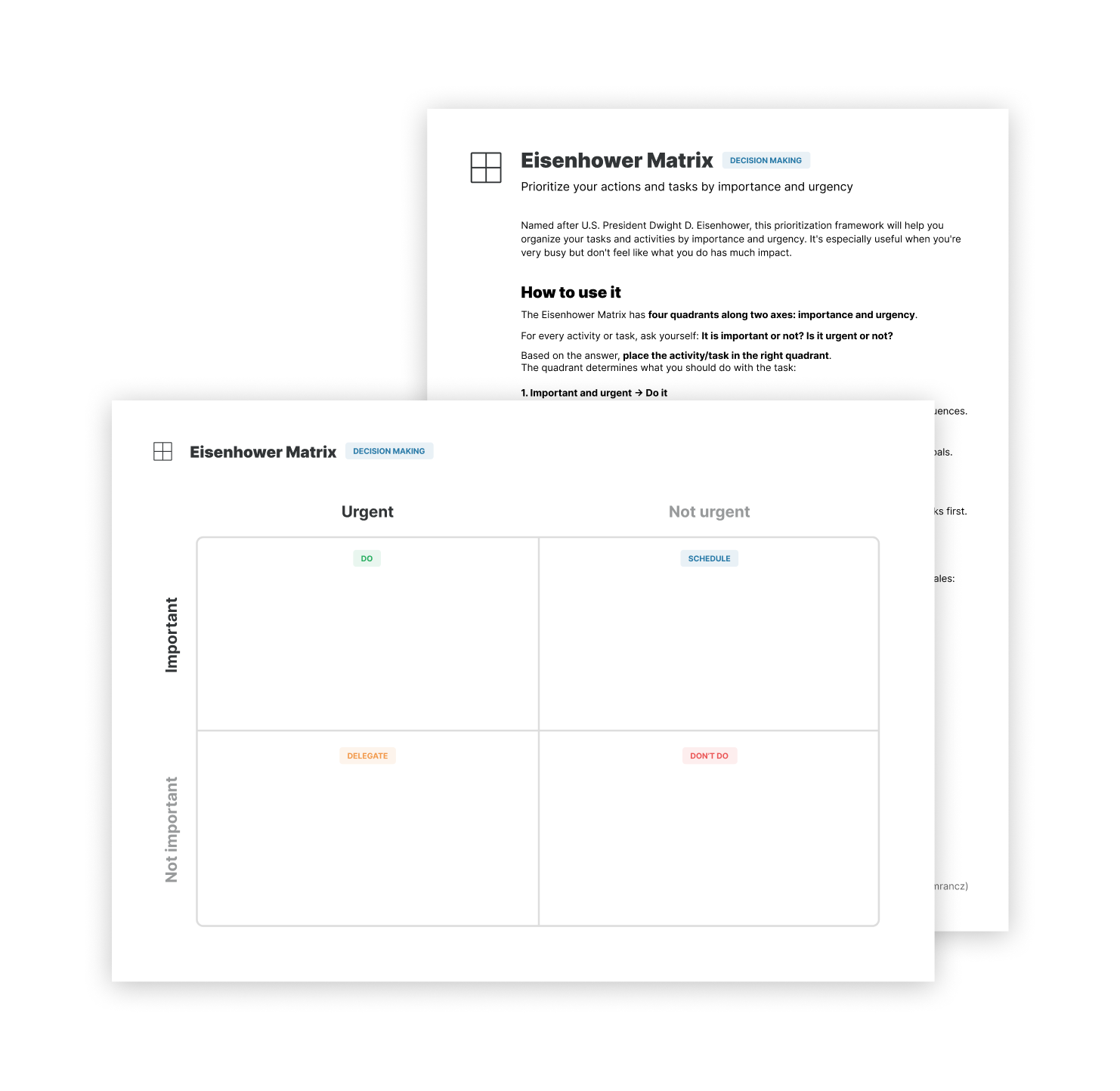Impact-Effort Matrix
DECISION MAKINGThe Impact-Effort Matrix is a powerful decision-making tool that helps you prioritize based on their potential impact and the effort required to complete them. It's particularly useful when you have a long list of tasks and need to determine where to focus your energy for the best results.
How to use it
The Impact-Effort Matrix consists of four quadrants along two axes: impact and effort. For every task or project, ask yourself: How impactful will this be? How much effort will it require?
Based on your answers, place the task in the appropriate quadrant. The quadrant will help you decide what to do with the task:
- High Impact, Low Effort → Quick Wins
- These are the tasks or projects that you should tackle first. They offer the highest return on investment for your effort.
- Examples include minor improvements that significantly enhance user experience or simple bug fixes that prevent major issues.
- High Impact, High Effort → Major Projects
- These items are important but require significant time and resources. Plan and execute them after the quick wins.
- Examples include developing new features, launching a marketing campaign, or redesigning a website.
- Low Impact, Low Effort → Fill-ins
- These can be done when you have spare time. They won't make a big difference but are easy to complete.
- Examples include routine admin work, small optimisations, or minor updates.
- Low Impact, High Effort → Thankless Tasks
- These tasks require a lot of effort but don't provide much return. Avoid or minimise these tasks whenever possible.
- Examples include overly complex processes that could be simplified or unnecessary meetings.
This matrix is flexible and can be used for both professional and personal tasks. It helps in identifying tasks that are worth your time and energy, and those that are not.
You can also use it on different timescales: for daily planning, weekly reviews, or long-term project management.
Additional tips
- Get accurate inputs
- Assess tasks realistically in terms of impact and effort. Avoid underestimating effort or overestimating impact. Try to get external inputs when needed.
- Review Regularly
- Revisit your matrix periodically to ensure tasks are still accurately placed as priorities and circumstances change.
- Combine with Other Tools
- Use the Impact-Effort Matrix in conjunction with other frameworks like the Eisenhower Matrix to refine your prioritisation further.
Example
Here are some examples of tasks that might go into the Impact-Effort Matrix:
| Low Effort | High Effort | |
| High Impact | Quick Wins: | Major Projects: |
| - Fixing minor bugs | - Developing new features | |
| - Enhancing user interface | - Redesigning the website | |
| Low Impact | Fill-ins: | Thankless Tasks: |
| - Routine admin work | - Overcomplicated processes | |
| - Small optimisations | - Unnecessary meetings |
Takeaway
The Impact-Effort Matrix helps you be more effective by prioritizing tasks that offer the best return on your effort. If you often find yourself working hard but not seeing significant results, this tool can help you identify where to focus for maximum impact. Use it to streamline your workload and ensure that your efforts are directed towards the most beneficial tasks.
Put this tool to practice
I've created a template (in PDF and Miro) for applying Impact-Effort matrix in practice. It includes a step-by-step reference guide with an example.
You can get it with Untools Vault which gives you instant access to all Untools premium templates and monthly exclusive deep-dives about thinking tools.
Preview of the template and guide:
